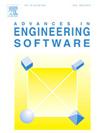Modeling reinforced concrete structures under fire conditions in GiD-OpenSees: Framework, validations, and implications
IF 4
2区 工程技术
Q2 COMPUTER SCIENCE, INTERDISCIPLINARY APPLICATIONS
引用次数: 0
Abstract
This paper presents modifications to the OpenSees for fire source code and the GiD-OpenSees interface to facilitate finite element (FE) macro modeling of reinforced concrete (RC) structural frames under fire conditions. In the FE framework, RC frames are discretized by 1-D line elements, and their cross-sections are further discretized by 2-D FE mesh. The mechanical analysis is configured for 1-D line elements, whereas the heat transfer analysis handles 2-D FE meshes. New material models (DamagePlastictyConcreteECT and DPMsteelECT) are developed based on the EN1992-1-2 stress–strain relations, and they explicitly consider transient creep (concrete), damage-plasticity (concrete), and plasticity (steel). Such an approach enables precise modeling of irreversible strain components, especially during strain reversal conditions. The existing GiD-OpenSees interface is extended to implement the new material models, FE framework, and automated thermo-mechanical analysis. Six numerical examples are presented, which include experimental validations and a comparison study against standard structural fire simulation software SAFIR. The results show that the developed framework is able to trace the structural response under fire to a high level of fidelity and robustly traverses strain-reversal conditions.
在 GiD-OpenSees 中模拟火灾条件下的钢筋混凝土结构:框架、验证和影响
本文介绍了对 OpenSees for fire 源代码和 GiD-OpenSees 界面的修改,以促进火灾条件下钢筋混凝土(RC)结构框架的有限元(FE)宏观建模。在有限元框架中,RC 框架由一维线元离散化,其横截面由二维有限元网格进一步离散化。机械分析采用 1-D 线元素,而传热分析则采用 2-D FE 网格。新材料模型(DamagePlastictyConcreteECT 和 DPMsteelECT)是基于 EN1992-1-2 应力应变关系开发的,它们明确考虑了瞬态蠕变(混凝土)、损伤塑性(混凝土)和塑性(钢)。这种方法可以对不可逆应变成分进行精确建模,尤其是在应变逆转条件下。对现有的 GiD-OpenSees 界面进行了扩展,以实现新的材料模型、FE 框架和自动热机械分析。本文介绍了六个数值示例,其中包括实验验证以及与标准结构火灾模拟软件 SAFIR 的对比研究。结果表明,开发的框架能够高保真地跟踪火灾下的结构响应,并能稳健地穿越应变反转条件。
本文章由计算机程序翻译,如有差异,请以英文原文为准。
求助全文
约1分钟内获得全文
求助全文
来源期刊

Advances in Engineering Software
工程技术-计算机:跨学科应用
CiteScore
7.70
自引率
4.20%
发文量
169
审稿时长
37 days
期刊介绍:
The objective of this journal is to communicate recent and projected advances in computer-based engineering techniques. The fields covered include mechanical, aerospace, civil and environmental engineering, with an emphasis on research and development leading to practical problem-solving.
The scope of the journal includes:
• Innovative computational strategies and numerical algorithms for large-scale engineering problems
• Analysis and simulation techniques and systems
• Model and mesh generation
• Control of the accuracy, stability and efficiency of computational process
• Exploitation of new computing environments (eg distributed hetergeneous and collaborative computing)
• Advanced visualization techniques, virtual environments and prototyping
• Applications of AI, knowledge-based systems, computational intelligence, including fuzzy logic, neural networks and evolutionary computations
• Application of object-oriented technology to engineering problems
• Intelligent human computer interfaces
• Design automation, multidisciplinary design and optimization
• CAD, CAE and integrated process and product development systems
• Quality and reliability.
 求助内容:
求助内容: 应助结果提醒方式:
应助结果提醒方式:


